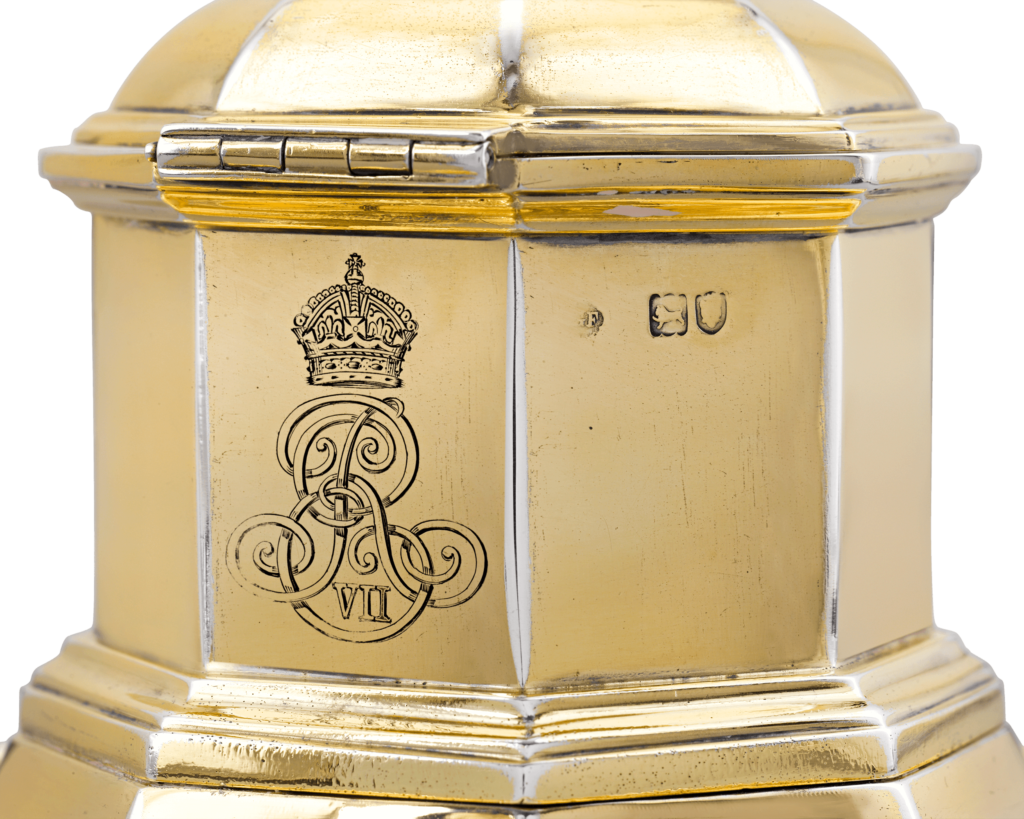Collectors items with a custodial history have long stood the test of time, offering a reliquary reminder of the past and how it has influenced the present. One such item, captures a brief moment in history when lustre and reverence were restored to the British monarchy following the reign of Queen Victoria (1837 - 1901). Commemorated with a custom engraving for the occasion, this one-of-kind silver-gilt inkstand and pen were used by Britain's King Edward VII to sign his coronation oath in Westminster Abbey in 1902.

The eldest son of Queen Victoria and Prince Albert of Saxe-Coburg and Gotha, King Edward VII, previously known as the Prince of Wales, was the longest-serving heir apparent in British history. In his youth, Albert Edward, also known as 'Bertie' within the family, was subjected to an extremely strict regime that would prepare him for his succession to the throne. As it is customary for members of the royal family, Prince Edward attended Oxford and Cambridge universities, and although his studies proved him to be disinterested - his true talents were those of his charm, sociability and tact, which ultimately played a significant role in his sovereignty.
Although his charismatic demeanor was admired and celebrated during his reign, his libertine and playboy reputation is perhaps what he is best known for, and is what ultimately resulted in a strain on his relationship with Queen Victoria. After the news of Edward’s affair with an actress broke, his father, Prince Albert, was affected greatly prior to succumbing to typhoid on December 14, 1861. Subsequently, Victoria excluded her heir from any real initiation into affairs of state. Not until he was more than 50 years old was he informed of cabinet proceedings.

In March 1893, Edward married Princess Alexandra of Denmark, and their first child, Albert Victor, was born ten months later, followed by five more siblings, including the future George V. Even though Edward was married, his numerous amorous liaisons were ongoing, including actress Lillie Langtry, Lady Randolph Churchill the mother of British prime minister Winston Churchill, actress Sarah Bernhardt, and more, in addition to Alice Keppel, the great Grandmother of the current Duchess of Cornwall, Camilla Parker Bowles.
Following Queen Victoria’s death on January 22, 1901, Edward VII knelt before the altar at Westminster Abbey, and swore on the Bible his coronation oath, a copy of which he signed using the present ink pen and stand. The historic moment is commemorated by an engraving on the top of the inkwell, which reads: "This standish was used by King Edward VII on signing the Coronation Oath in Westminster Abbey being held on the occasion by Victor Albert First Viscount Churchill August 9th 1902." The octagonal form is further adorned by the Royal Arms and cypher of King Edward VII, with the initials “ER” for “Edward Rex.”


The inkwell and pen are accompanied by a hand-written letter from Randall Davidson (also known as Winton), then the Bishop of Winchester and later Archbishop of Canterbury, to Victor Spencer, 1st Viscount Churchill, in which he explains that the King personally chose this pen for his use at his coronation.
Davidson and Churchill both played a significant role in planning the coronation, though Churchill perhaps more so; he served as Lord Chamberlain for the big event. This branch of the Churchill family (cousins of Sir Winston Churchill) had a long history in England, playing a significant role in British politics for over two centuries. Viscount Churchill, the son of Francis Spencer, 2nd Baron Churchill, became particularly important to the Royal family. As a youth, he served as a Page of Honor to Queen Victoria, and later as Lord in Waiting in the Royal Household, before becoming Lord Chamberlain to Edward VII in 1902. He would later serve as Master of Robes at the coronation of King George V, Edward’s son and successor.
As king, Edward VII played a role in the restoring awe-inspiring tradition and ceremonies to the monarchy that had lapsed during his mother’s reign. He was a key leader in the modernization of the British Home Fleet and the reorganization of the British Army, and his advocacy for military reform as well as naval reform did much to avert British unpreparedness for World War I. He not only fostered and grew positive relationships between Britain and other European countries, especially France, but reinstituted public displays and broadened the range of people with whom royalty socialized. The Edwardian Era, which spanned Edward’s reign and was named after him, correlated with the onset of a new century that heralded significant changes in technology and society overall.
An avid smoker, King Edward VII suffered from chronic bronchitis, and in May 1910 took a turn for the worse when he suffered a series of heart attacks. On May 6th, the King passed. His state funeral, held in the weeks following his death, was the largest possibly the largest assembly of royalty ever seen. Even though his reign was short, his keen sense for diplomacy and governing proved him a greater success than anyone ever expected.
The inkwell and pen from King Edward VII’s coronation entered the Viscount Churchill’s personal collection following the event, where it eventually descended to Victor, 3rd Viscount Churchill, who died in 2017. Highly prized in the family for over a century, this pair has only recently appeared on the market. That its provenance boasts the names of both King Edward VII and Churchill makes it an exceptional rarity that holds a significant place in Royal history.






